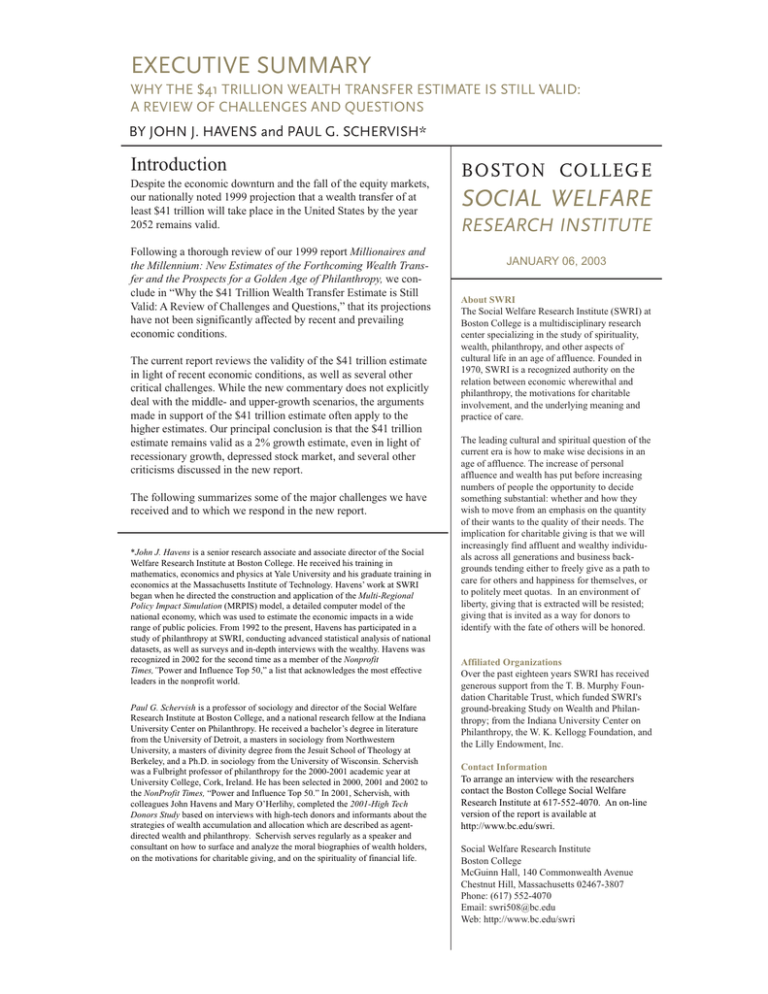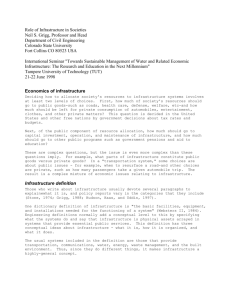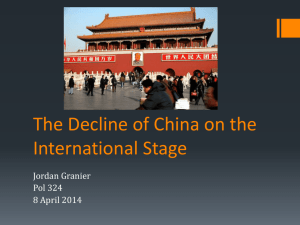
EXECUTIVE SUMMARY
WHY THE $41 TRILLION WEALTH TRANSFER ESTIMATE IS STILL VALID:
A REVIEW OF CHALLENGES AND QUESTIONS
BY JOHN J. HAVENS and PAUL G. SCHERVISH*
Introduction
Despite the economic downturn and the fall of the equity markets,
our nationally noted 1999 projection that a wealth transfer of at
least $41 trillion will take place in the United States by the year
2052 remains valid.
Following a thorough review of our 1999 report Millionaires and
the Millennium: New Estimates of the Forthcoming Wealth Transfer and the Prospects for a Golden Age of Philanthropy, we conclude in “Why the $41 Trillion Wealth Transfer Estimate is Still
Valid: A Review of Challenges and Questions,” that its projections
have not been significantly affected by recent and prevailing
economic conditions.
The current report reviews the validity of the $41 trillion estimate
in light of recent economic conditions, as well as several other
critical challenges. While the new commentary does not explicitly
deal with the middle- and upper-growth scenarios, the arguments
made in support of the $41 trillion estimate often apply to the
higher estimates. Our principal conclusion is that the $41 trillion
estimate remains valid as a 2% growth estimate, even in light of
recessionary growth, depressed stock market, and several other
criticisms discussed in the new report.
The following summarizes some of the major challenges we have
received and to which we respond in the new report.
*John J. Havens is a senior research associate and associate director of the Social
Welfare Research Institute at Boston College. He received his training in
mathematics, economics and physics at Yale University and his graduate training in
economics at the Massachusetts Institute of Technology. Havens’ work at SWRI
began when he directed the construction and application of the Multi-Regional
Policy Impact Simulation (MRPIS) model, a detailed computer model of the
national economy, which was used to estimate the economic impacts in a wide
range of public policies. From 1992 to the present, Havens has participated in a
study of philanthropy at SWRI, conducting advanced statistical analysis of national
datasets, as well as surveys and in-depth interviews with the wealthy. Havens was
recognized in 2002 for the second time as a member of the Nonprofit
Times,”Power and Influence Top 50,” a list that acknowledges the most effective
leaders in the nonprofit world.
Paul G. Schervish is a professor of sociology and director of the Social Welfare
Research Institute at Boston College, and a national research fellow at the Indiana
University Center on Philanthropy. He received a bachelor’s degree in literature
from the University of Detroit, a masters in sociology from Northwestern
University, a masters of divinity degree from the Jesuit School of Theology at
Berkeley, and a Ph.D. in sociology from the University of Wisconsin. Schervish
was a Fulbright professor of philanthropy for the 2000-2001 academic year at
University College, Cork, Ireland. He has been selected in 2000, 2001 and 2002 to
the NonProfit Times, “Power and Influence Top 50.” In 2001, Schervish, with
colleagues John Havens and Mary O’Herlihy, completed the 2001-High Tech
Donors Study based on interviews with high-tech donors and informants about the
strategies of wealth accumulation and allocation which are described as agentdirected wealth and philanthropy. Schervish serves regularly as a speaker and
consultant on how to surface and analyze the moral biographies of wealth holders,
on the motivations for charitable giving, and on the spirituality of financial life.
BOSTON COLLEGE
SOCIAL WELFARE
RESEARCH INSTITUTE
JANUARY 06, 2003
About SWRI
The Social Welfare Research Institute (SWRI) at
Boston College is a multidisciplinary research
center specializing in the study of spirituality,
wealth, philanthropy, and other aspects of
cultural life in an age of affluence. Founded in
1970, SWRI is a recognized authority on the
relation between economic wherewithal and
philanthropy, the motivations for charitable
involvement, and the underlying meaning and
practice of care.
The leading cultural and spiritual question of the
current era is how to make wise decisions in an
age of affluence. The increase of personal
affluence and wealth has put before increasing
numbers of people the opportunity to decide
something substantial: whether and how they
wish to move from an emphasis on the quantity
of their wants to the quality of their needs. The
implication for charitable giving is that we will
increasingly find affluent and wealthy individuals across all generations and business backgrounds tending either to freely give as a path to
care for others and happiness for themselves, or
to politely meet quotas. In an environment of
liberty, giving that is extracted will be resisted;
giving that is invited as a way for donors to
identify with the fate of others will be honored.
Affiliated Organizations
Over the past eighteen years SWRI has received
generous support from the T. B. Murphy Foundation Charitable Trust, which funded SWRI's
ground-breaking Study on Wealth and Philanthropy; from the Indiana University Center on
Philanthropy, the W. K. Kellogg Foundation, and
the Lilly Endowment, Inc.
Contact Information
To arrange an interview with the researchers
contact the Boston College Social Welfare
Research Institute at 617-552-4070. An on-line
version of the report is available at
http://www.bc.edu/swri.
Social Welfare Research Institute
Boston College
McGuinn Hall, 140 Commonwealth Avenue
Chestnut Hill, Massachusetts 02467-3807
Phone: (617) 552-4070
Email: swri508@bc.edu
Web: http://www.bc.edu/swri
2
Challenge 1: What about the economy?
The wealth transfer estimate is based on the robust growing economy during the latter half of the 1990s and fails to
account for current and/or future recessions and downturns in equity, real estate, or other markets.
The $41 trillion wealth transfer estimate assumes only a 2%
secular real rate of growth in the $32 trillion of personally held
wealth in 1998 rather than the high rates of growth in personally held wealth attained in the late 1990s. Even if recessions
are more common than expansions during the 55 years
spanned by the simulation, the $41 trillion estimate, which
assumes only a 2% secular trend in the growth of personally
held wealth, is based on growth rates below historic secular
trends.
Challenge 2: Did the drop in stock values
affect personal wealth?
The wealth transfer estimate is based on an unusually high
level of personally owned wealth when stocks and bonds
were near historic peaks; the estimate would be significantly lower were it based on the current level of personally owned wealth.
Like the secular growth rates, the $32 trillion baseline estimate
of personally owned wealth used in the original report is a
conservative, low estimate and compares with the estimates
released in 2001 by Federal Reserve Flow of Funds Accounts
implying that total household wealth amounted to at least $32
trillion in 1998. Although household wealth surpassed $32
trillion after 1998, reaching a peak of about $36 trillion in
1999, in the second quarter of 2002 it returned to its 1998 level
of $32 trillion (1998 dollars). Therefore, were the wealth
transfer estimates based on the current level of household
wealth instead of the 1998 value, they would remain unchanged. Specifically, the low-growth scenario would still
produce an estimate of $41 trillion.
Challenge 3: “We’re spending our
children’s inheritance”--is the bumper
sticker correct?
The majority of Americans start to spend down their assets
when they reach retirement and the wealth transfer estimates do not take into account this expenditure pattern.
Most American families do begin to spend down their assets
when they reach retirement and most non-wealthy families
continue to spend down their assets thereafter. However, for
most wealthy families, a brief period of spending down their
assets at retirement age is followed by a growth of assets in
their later years that exceeds their dissaving (drawing down of
assets). The low-growth scenario assumes that both wealthy
and non-wealthy Americans consume their assets during
retirement faster than in reality, thus allowing for retired
American parents to spend an even larger amount of "their
children's inheritance" without reducing the $41 trillion estimate.
Challenge 4: Longer life, less wealth?
Americans have been living longer and are projected to live
even longer in the future. The average American family
will be spending their assets for a longer period of time,
leaving smaller amounts of wealth to be transferred than is
estimated by the simulation.
Not counting the effect of greater labor force participation
among older workers, the net effect of an additional year of
life for all Americans would be to decrease the $41 trillion
estimate, but to decrease it by less than $0.3 trillion. For all
SOCIAL WELFARE RESEARCH INSTITUTE
retirees regardless of wealth, the final estates of those that
remain in the labor force will have a larger value than the
estates of those who do not work during retirement years.
Thus, when coupled with increased labor force participation
among older workers, an additional year of life for all Americans could actually increase the $41 trillion estimate by a small
amount.
Challenge 5: Do annuities decrease the
wealth transfer?
If the trend toward increased annuitization continues, the
amount of wealth to be transferred will decline because in
order to purchase an annuity, individuals need to draw
down their assets and because an annuity ceases to exist
when the recipient dies, and so contributes no value to the
estate of the recipient/decedent.
If the $41 trillion estimate does not take into account the
reduction in wealth due to increased amounts of annuities, it
will over-estimate the coming wealth transfer. We conclude
that on balance the $41 trillion estimate is not compromised by
the current level and trends in annuitization, or by the way the
current simulation model takes them into account. If anything,
the growth in defined-contribution pensions, the tendency to
receive distributions from defined-contribution plans as assets,
and the tendency to spend from such assets at a lower rate than
had the pension been received as annuity income, combine to
make it likely that more than $41 trillion will be transferred.
Challenge 6: What will be the baby
boomers share?
The projected estimate is unrealistic since the baby-boom
generation, the largest generation ever, will not inherit
anything close to $41 trillion.
Many queries about the $41 trillion wealth transfer estimate—
often from boomers themselves wrongly assume two things
about our report: first, that the entire transfer of wealth is going
to heirs; and second, that it is going only to boomers. First,
"wealth transfer" is not synonymous with "inheritance." Our
original report carefully points out that only $25 trillion of the
$41 trillion transfer will pass from decedents' estates to their
heirs. The remaining $17 trillion will go to estate taxes,
charitable bequests, and estate settlement expenses. Second, it
is equally important to understand that while $25 trillion is
going to heirs, that figure is the amount of wealth that will be
inherited from 1998 through 2052 by all generations—and not
just the boomers. Boomers may well inherit $7.2 trillion, but
the majority of the inheritances will be transferred to subsequent generations, including the children and grandchildren of
the boomers. As the boomer generation ages and dies during
the 55-year period, their role in the wealth transfer process will
be far greater as benefactors than as beneficiaries.
Challenge 7: Is it true that only 2% of estates participate in the wealth transfer?
Only approximately 2% of estates, those of the wealthiest
citizens who die each year, are required to file federal
estate tax forms. Since wealth transfer is concentrated
among this very small fraction of estates, the vast majority
of estates will not participate significantly in the $41 trillion wealth transfer.
The $41 trillion is an estimate of total wealth transfer via final
estates of the entire 1998 adult population, regardless of the
size of the estate. The inequality of the size of estates does not
affect the $41 trillion estimate and how it is divided: $6.0
trillion in total charitable bequests, $24.6 trillion in total
bequests to heirs, $8.5 trillion in total estate taxes, and $1.6
trillion in total estate fees.
EXECUTIVE SUMMARY: THE $41 TRILLION WEALTH TRANSFER ESTIMATE IS STILL VALID
Challenge 8: How will heirs benefit?
The $41 trillion transfer is not a realistic estimate of wealth
transfer since the vast majority of heirs will receive small
inheritances, if any.
From the outset, it must be noted that not all of the $41 trillion
transfer is going to heirs, and that substantial amounts are
going to charity, taxes, and fees. The share of the low-growth
estimate of wealth transfer going to heirs is $25 trillion. Because most estates have more than one heir, the size of inheritance will be relatively small per heir, and the effect will be
diffused throughout the population. The fundamental point in
regard to the relative shares of the estate going to heirs, to
taxes, to charity, or to estate fees—all of which are documented in the original report—is that they do not affect the
validity of the $41 trillion wealth transfer estimate.
Challenge 9: Why is SWRI’s estimate four
times greater than the previous highest
estimate?
Robert B. Avery and Michael S. Rendall estimated an
intergenerational wealth transfer of $10.4 trillion for the
55-year period from 1990 through 2044. Why is this simulation figure four times higher?
Avery and Rendall's $10.4 trillion estimate is not an estimate
of the transfer of wealth from the entire 1989 adult population
over the subsequent 55 years, but an estimate only of wealth to
be transferred from the World War II generation to their baby
boom children, estate taxes, charitable bequests, and estate
fees. In contrast, SWRI's $41 trillion estimate is a low estimate of wealth to be transferred over the 55-year period from
1998-2052 from the estates of the entire 1998 adult population
(age 18 and over) to heirs, taxes, charity, and fees. SWRI's
goal was to estimate the total wealth transfer from the entire
1998 adult population during the 55 years from 1998 through
2052, rather than from the segment aged 50 and older with
children. SWRI's simulation also starts with a larger pool of
wealth. The wealth of the 1998 population was 5.27% larger in
real terms compared to the wealth of the 1989 population.
Finally, SWRI's simulation includes wealth transferred from
aging baby boomers as well as wealth transferred to them. The
bulge in the size of the boomer generation produces a similar
bulge in the number of estates and the aggregate amount to be
transferred when the boomers die.
_____________________________________________________
From:
“Why the $41 Trillion Wealth Transfer
Estimate is Still Valid: A Review of Challenges and Questions”
by John J. Havens and Paul G. Schervish
Published in Journal of Gift Planning, Vol. 7, No. 1,
January 2003, pp.11-15, 47-50.
! Copyright 2003, Social Welfare Research Institute. All
rights reserved.
3










